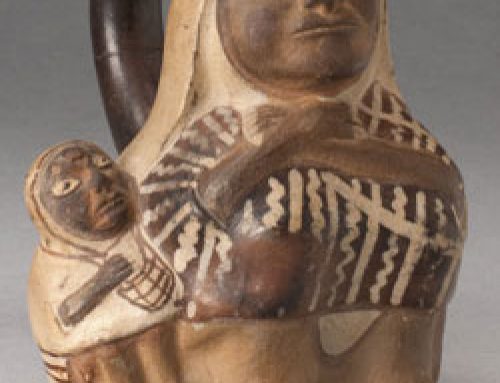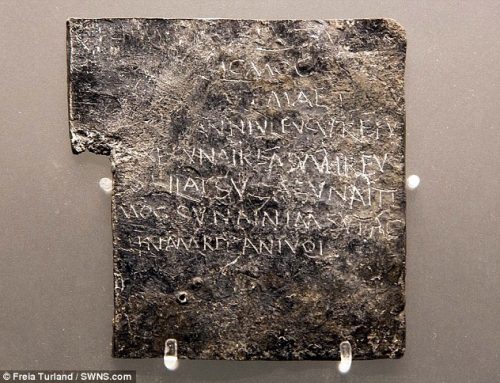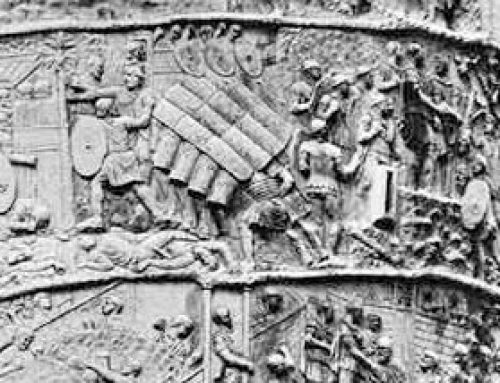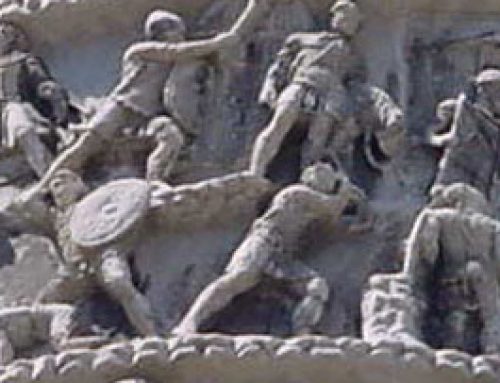
Rome geography: Tiber island
Tiber river and trade
The city of Rome itself has tremendous environmental advantages, which made it easier for Rome to become an important city. Rome is located at the first place that people can easily cross the Tiber river, so it is the natural location of the main north-south road in Italy.
Stone Age Italy
More Ancient Rome articles

Geography of Rome: the ancient city of Rome was located where the north-south road crossed the Tiber river.
The reason you can cross the Tiber at Rome is that there is an island in the river there (this is the same as at Paris, and many other cities). Probably the first Romans made a lot of profit from charging people to let them use the island to cross the river – charging tolls.
Salt flats near the city of Rome
There are also big salt flats near the city.Because salt was so valuable in the ancient world for preserving meat and fish, selling the salt made Romans rich.
History of salt
Also the riverboats going up and down the Tiber, from east to west and back again, could stop at Rome. So right from the beginning, the ancient Roman environment helped the Romans get rich.
Roman empire’s many climate zones

Black Forest in Northern Europe
As the Romans expanded their empire, they encountered many different climate zones. There were deserts, mountains, wetlands, forests, and everything else.
More about the Alps
Northern Europe’s environment
Africa and the Sahara
The great variety of environments helped the Romans get lots of different food and materials. They could get tin from England, and wood from Germany, and cotton from Egypt, and silver from Spain. There was plenty of gold. The Romans produced and sold wool and linen, glass and wine.
What is tin?
All about silver
History of cotton
A warm, mild climate

A Ribat, or fort, in North Africa
The Romans also had the advantage of a good climate. During most of the time of the Roman Empire, Europe and the Mediterranean were unusually warm, about as warm as they are right now. That weather seems to have been good for Roman farming. The Romans brought Mediterranean crops like wine grapes and olives much further north than they normally grew.
History of wine
More about olive oil
Climate change and the fall of Rome

Roman carving of a harvesting machine
But during the 200s AD, the weather got cooler. The cooler weather forced wine and olive growers to move south. It may even have made it harder to grow wheat and barley. The cooler weather made it harder to heat houses in the north.
History of wheat
What is barley?
How did Romans heat houses?
This may have helped cause problems for the Romans. The cold weather may have encouraged the Germans and the Sassanians to invade the Roman Empire. It may have encouraged many people to revolt inside the Empire as well.
Who were the Sassanians?
The fall of Rome
The fall of Rome in the 400s AD may also be related to this cooler climate, which lasted into the Early Middle Ages, until the 600s AD.
Did you find out what you needed about Rome’s geography and the Roman climate? Let us know in the comments!





Well, the climate affects everything about farming. The Roman climate was warm enough to plant wheat and barley, so they didn’t have to live on oats and rye, for example. And it was warm enough to grow grapes for wine, and olive trees for olive oil, and figs. When the Romans conquered land further north, they had to grow and eat different things: beer instead of wine, and butter instead of olive oil. When they conquered Egypt, that was hotter and drier, and people used mostly palm oil instead of olive oil, and ate mostly dates.
hi
Thanks for contributing! You’ll find our article about Roman food here: https://quatr.us/food-2/mediterranean-food-roman-empire.htm and about Egyptian food here: https://quatr.us/egypt/people-eat-ancient-egypt.htm
Well, the climate affects everything about farming. The Roman climate was warm enough to plant wheat and barley, so they didn’t have to live on oats and rye, for example. And it was warm enough to grow grapes for wine, and olive trees for olive oil, and figs. When the Romans conquered land further north, they had to grow and eat different things: beer instead of wine, and butter instead of olive oil. When they conquered Egypt, that was hotter and drier, and people used mostly palm oil instead of olive oil, and ate mostly dates.
hi
what other empires surrounded the Roman empire
To the south, there was the Carthaginian Empire and Sudan. To the east, the Athenian Empire and the Persian Empire.
https://quatr.us/history/north-africa-history-carthage.htm
https://quatr.us/africa/african-meroe-and-aksum-sudan.htm
https://quatr.us/greeks/classical-greek-history.htm
https://quatr.us/history/xerxes-alexander-later-persian-empire.htm
why do you keep say that it may have done this
Because nobody knows for sure. Historians think that’s the most likely explanation, but they’re still working on this problem.
How did the climate affect Roman farming? If you don’t have an answer knowing how the climate affected them in general would be nice.
Well, the climate affects everything about farming. The Roman climate was warm enough to plant wheat and barley, so they didn’t have to live on oats and rye, for example. And it was warm enough to grow grapes for wine, and olive trees for olive oil, and figs. When the Romans conquered land further north, they had to grow and eat different things: beer instead of wine, and butter instead of olive oil. When they conquered Egypt, that was hotter and drier, and people used mostly palm oil instead of olive oil, and ate mostly dates.
can you help me?
I’ll try, if you ask me a specific question.
A.D. comes before the date.
You can do it either way.
can you name some relly cool mountains and rivers
I feel like if I choose some I’ll be hurting the feelings of the mountains and rivers that get left out! You can read more about mountains here: https://quatr.us/geology/plate-tectonics-earthquakes-volcanoes.htm and more about the Nile river here: https://quatr.us/egypt/environment-ancient-egypt.htm
what did the ancient Romans face when they were starting.
I think that’s in the article? But also read this: https://quatr.us/romans/etruscans-history-italy.htm
What is the agricultural adavantages for ancient rome?
There’s an answer to that in the article.
how did the area of Rome affect its development?
I think the article answers that question. Could you ask a more specific question please?
What are two difficulties you think the Romans would face based on their geography? I need to know this for my research
Don’t you mean, your teacher wants you to think about this for your homework? I think you’ll learn more by thinking about Europe’s geography for yourself.
What is the date of when you posted this article because i cant find it anywhere
The date is at the end of each article.
What were the agricultural practices around the city proper?
In the early Republic, farmers near Rome and in Rome itself grew the things people wanted to eat: wheat, barley, millet, chickpeas, lentils, figs, olives, grapes, cabbages, onions, apples. They used oxen or sometimes donkeys to pull their plows. But by the time of the Late Republic Rome was too big a city to grow all its own food. Most of the wheat and barley and olive oil came to Rome on boats across the Mediterranean. So farmers near Rome probably specialized in fresh fruits and vegetables, and didn’t grow so much wheat and barley or olives anymore.
How does the environment define the culture/civilization?
That sounds like your homework? I’m sure you will learn more by doing your own thinking than by having me do it for you.
Did not answer my question and i really was hoping that it would.
What’s your question? I’ll try to answer it, and if it’s a good question I’ll add that information to the article for other kids!